The DirectX 12 Performance Preview: AMD, NVIDIA, & Star Swarm
by Ryan Smith on February 6, 2015 2:00 PM EST- Posted in
- GPUs
- AMD
- Microsoft
- NVIDIA
- DirectX 12
DirectX 12 vs. Mantle, Power Consumption
Although the bulk of our coverage today is going to be focused on DirectX 12 versus DirectX 11, we also wanted to take a moment to also stop and look at DirectX 12 and how it compares to AMD’s Mantle. Mantle offers an interesting point of contrast being that it has been in beta longer than DirectX 12, but also due to the fact that it’s an even lower level API than DirectX 12. Since Mantle only needs to work on AMD’s GPUs and can be tweaked for AMD’s architectures, it offers AMD the chance to exploit their GPUs in a few additional ways that a common, cross-vendor API like DirectX 12 cannot.
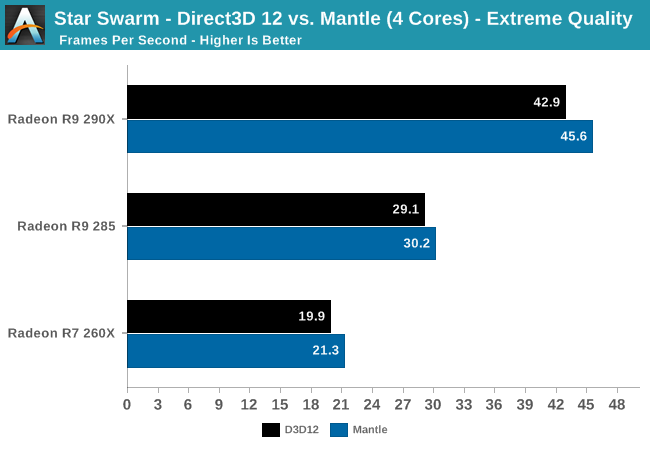
With 4 cores we find that AMD achieves better results with Mantle than DirectX 12 across the board. The gains are never very great – a few percent here and there – but they are consistent and just outside our window of variability for the Star Swarm benchmark. With such a small gain there are a number of factors that can possibly explain this outcome – better developed drivers, better developed application, further benefits of working with a known hardware platform – so we can’t credit any one factor. But it’s safe to say that at least in this one instance, at this time, Star Swarm’s Mantle rendering path produces even better results than its DirectX 12 path on AMD cards.
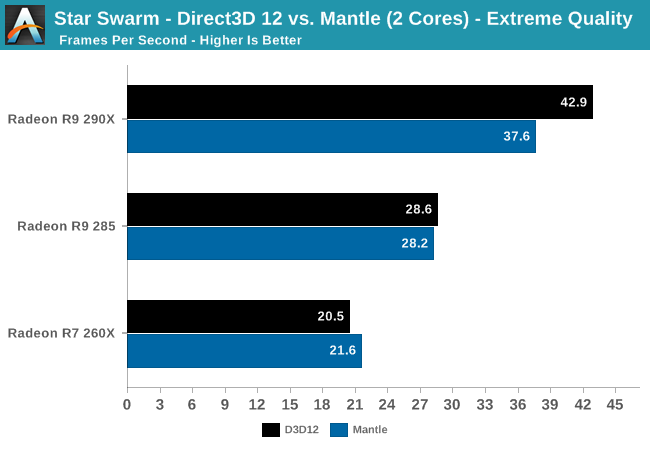
On the other hand, Mantle doesn’t seem to be able to accommodate a two-core situation as well, with the 290X seeing a small but distinct performance regression from switching to Mantle from DirectX 12. Though we didn’t have time to look at an AMD APU for this article, it would be interesting to see if this regression occurs on their 2M/4C parts as well as it does here; AMD is banking heavily on low-level APIs like Mantle to help level the CPU playing field with Intel, so if Mantle needs 4 CPU cores to fully spread its wings with faster cards, that might be a problem.

Diving deeper, we can see that part of the explanation for our Mantle performance regression may come from the batch submission process. DirectX 12 is unexpectedly well ahead of Mantle here, with batch submission taking on average a bit more than half as long as it does under Mantle. As batch submission times are highly correlated to CPU bottlenecking on Star Swarm, this would imply that DirectX 12 would bottleneck later than Mantle in this instance. That said, since we’re so strongly GPU-bound right now it’s not at all clear if either API would be CPU bottlenecked any time soon.
Update: Oxide Games has emailed us this evening with a bit more detail about what's going on under the hood, and why Mantle batch submission times are higher. When working with large numbers of very small batches, Star Swarm is capable of throwing enough work at the GPU such that the GPU's command processor becomes the bottleneck. For this reason the Mantle path includes an optimization routine for small batches (OptimizeSmallBatch=1), which trades GPU power for CPU power, doing a second pass on the batches in the CPU to combine some of them before submitting them to the GPU. This bypasses the command processor bottleneck, but it increases the amount of work the CPU needs to do (though note that in AMD's case, it's still several times faster than DX11).
This feature is enabled by default in our build, and by combining those small batches this is the likely reason that the Mantle path holds a slight performance edge over the DX12 path on our AMD cards. The tradeoff is that in a 2 core configuration, the extra CPU workload from the optimization pass is just enough to cause Star Swarm to start bottlenecking at the CPU again. For the time being this is a user-adjustable feature in Star Swarm, and Oxide notes that in any shipping game the small batch feature would likely be turned off by default on slower CPUs.
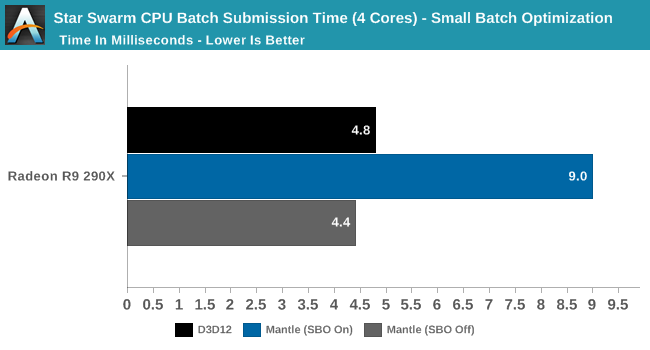
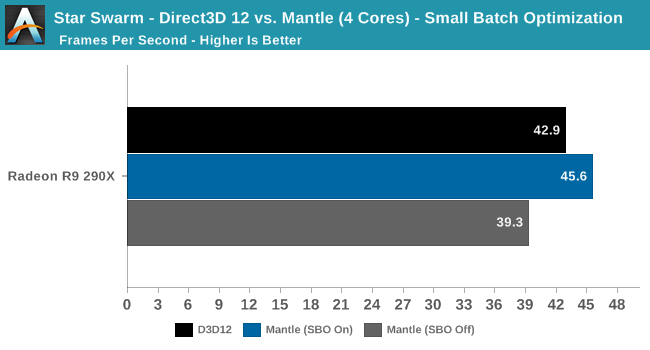
If we turn off the small batch optimization feature, what we find is that Mantle' s batch submission time drops nearly in half, to an average of 4.4ms. With the second pass removed, Mantle and DirectX 12 take roughly the same amount of time to submit batches in a single pass. However as Oxide noted, there is a performance hit; the Mantle rendering path's performance goes from being ahead of DirectX 12 to trailing it. So given sufficient CPU power to pay the price for batch optimization, it can have a signifcant impact (16%) on improving performance under Mantle.
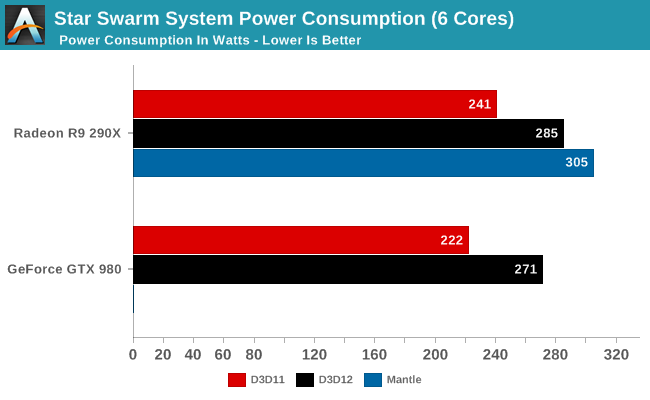
Finally, we wanted to take a quick look at power consumption among cards and APIs. To once again repeat what we said earlier, Star Swarm is an imperfect, non-deterministic benchmark, and coupled with the in-development status of DirectX 12 everything here is subject to change. However we thought this was interesting enough to include in our evaluation.
As expected, the increased throughput from DirectX 12 and Mantle drive up system power consumption. With the CPU no longer the bottleneck, the GPU never gets a chance to idle and video card power consumption ramps up to full load.










245 Comments
View All Comments
jeffkibuule - Saturday, February 7, 2015 - link
Right, it's a secret to the public, not so much to the engineers.Jumangi - Friday, February 6, 2015 - link
MS is a much bigger company so the resources they have give a big edge. I also suspect while AMD publicly still supports Mantle they probably aren't doing much for the future as they are smart enough, or I hope they are smart enough, to realize DX 12 makes Mantle irrelevant.toffty - Friday, February 6, 2015 - link
I wouldn't say Mantle is irrelevant since Directx12 is Windows 10 and Xbox One only. Mantle is for Window < 10, linux and OSX. It will be competing against OpenGL in that space, true, but if it's easier to port applications made with Mantle to Xbox One, Mantle will have a leg up on OpenGL. Mantle also needs to becomes open and nVidia supports it too.Penti - Saturday, February 7, 2015 - link
There is no mantle for anything else than Windows. PS4 uses it's own API's, Nintendo uses it's own API's, X1 doesn't straight up run the same runtime or API as DX on Windows and already have low-level features, D3D11.X is a superset of D3D/DX11. Games are normally DX/HLSL to begin with, so you don't need to mess around with shaders that much and converting formats. Converting GLSL to HLSL is practical though. Many engines also has their own shader languages and systems making stuff like Mantle's shading language similarities irrelevant. Most will design for something else as their first path than Mantle.Jumangi - Saturday, February 7, 2015 - link
Fanboys can get mad but Linux and OSX are irrelevant for mainstream gaming. So yes Mantle has no real future and will be forgotten about in a couple of years.bloodypulp - Sunday, February 8, 2015 - link
Keep on dreaming, Nvidia fangirl. Mantle is coming for SteamOS(Linux). Count on it.yannigr2 - Friday, February 6, 2015 - link
Mantle was the catalyst to bring DX12 closer. No reason for AMD to spend much resources on Mantle now. Job is done.Notmyusualid - Friday, February 6, 2015 - link
More or less my thinking too. Best to keep us all on the same page, so to speak.Respect to AMD, but let us all join the DX12 train together....
AnnonymousCoward - Saturday, February 7, 2015 - link
Not necessarily. How do you know it wasn't MS's idea even? Look at Khato's post above.tipoo - Friday, February 6, 2015 - link
What's the support status of Intels chips which are going to get it? I think all Iris models will, and a few of the higher end HD Graphics series parts will. Are they currently supported?It would be interesting to see if this could push the Iris Pro 5200 any further. Though this is more for the flip situation of a weak CPU with a strong GPU, rather than this strong CPU with a modest GPU.